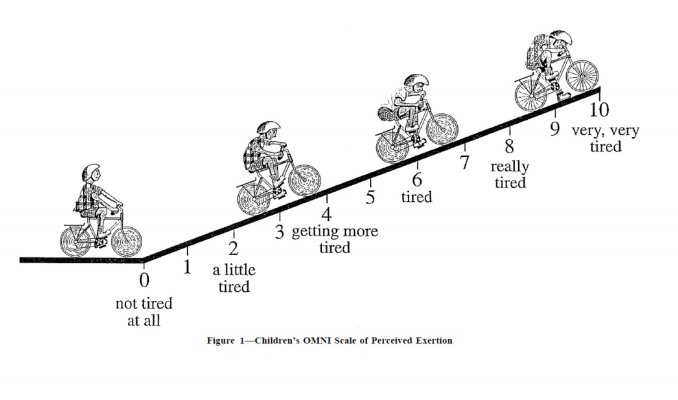Measurement and Evaluation of Human Performance
6.1 Statistical Analysis
Error Bars
Error Bars: are a graphical representation of the variability of the data. They depict the standard deviation from the mean.
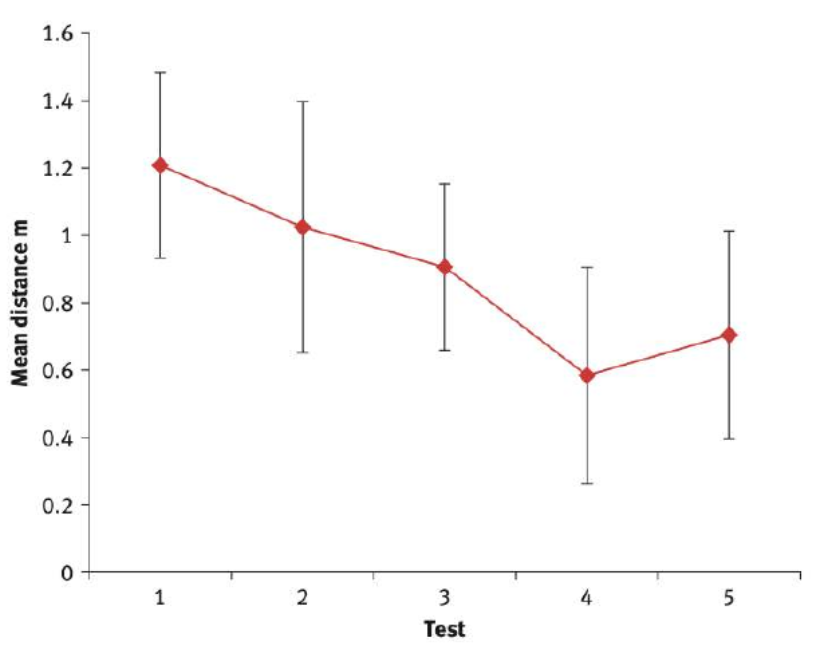
Mean and Standard Deviation
Mean: the mathematical average of a set of 2 or more numbers.

Standard Deviation: a statistic that measures the dispersion of a data relative to its mean.

Standard deviation is used to summarize the spread of values around the mean, and within a normal distribution approximately 68% and 95% fall within + or - 1 or 2 standard deviation points respectively.
Comparing Spreads of Data
A small standard deviation indicates that the data is clustered closely around the mean value.
Conversely, a large standard deviation indicates a wider spread around the mean.
Coefficient Variation
Coefficient Variation: the ratio of the standard deviation to the mean expressed as a percentage.

Significance of Difference Between Two Sets of Data
For the t-test to be applied, ideally the data should have a normal distribution and a sample size of at least 10. The t-test can be used to compare two sets of data and measure the amount of overlap. Only two-tailed, paired, and unpaired t-tests are expected.
Two-Tailed T Test: a method in which the critical area of a distribution is two-sided and tests whether a sample is greater than or less than a certain range of values.
Paired T Test: a statistical procedure used to determine whether the mean difference between two sets of observations is zero.
Unpaired T-Test: a statistical procedure that compares the averages/means of two independent or unrelated groups to determine if there is a significant difference between the two.
Probability: the likelihood of the difference between two data sets being statistically significant.
Correlation
Correlation: the relationship between two variables.
If both variables increase, or both variables decrease, this is described as a positive correlation.
If one variable increases the other decreases (or vice versa) this is described as a negative correlation.
A correlation can be identified from observations without a scientific experiment. However, just because there exists a relationship between two variables, this does not indicate that there is necessarily a causal relationship between the two - there may be other variables influencing the relationship that have not been shown. To establish cause in a relationship a controlled scientific experiment must be done.
6.2 Study Design
Specificity, Accuracy, Reliability, and Validity in Fitness Testing
Specificity: a test directly targets the fitness component most relevant to a particular activity or sport.
A marathon runner fitness assessment would prioritize endurance tests like a long-distance run, not a weightlifting max.
Specificity ensures the test reflects the demands of the target activity.
Accuracy: how close the test results are to the true fitness level.
A stopwatch versus an electronic timing system for a sprint. The electronic system provides a more accurate reflection of the actual speed.
Accurate tests give a clearer picture of strengths and weaknesses.
Reliability: a test that yields consistent results when repeated under similar conditions.
A reliable test should produce similar scores for both attempts.
Reliability ensures the test isn't influenced by random factors, giving confidence in the results.
Validity: ensures the test measures what it's supposed to measure in the context of fitness.
A valid VO2 max test truly reflects the body's maximum oxygen uptake, a crucial aspect of aerobic fitness.
A valid test provides meaningful data for gauging fitness levels in a specific area.
Using repeated measures for higher validity.
Importance of Study Design
Causality in experimental results by the inclusion of:
Control Groups: used to compare to an experimental group in a test of a causal hypothesis
randomization
Placebos: to keep the participants unknown to whether they are being given the causal agent that is being tested
Blinding: staff blinded to treatment allocation to minimize bias
Double-blinding: a control group test where neither the evaluator nor the participant knows which items are controls; they are randomly assigned
Statistical Analysis: the collection and interpretation of data to uncover patterns and trends.
Double-Blind Experiment: an experiment in which neither the participants nor the experimenters know who has been given the placebo.
Weak Experimental Design:

With a Control Group:

With a Placebo:

PAR-Q
Many fitness tests involve physical exertion, sometimes intense. To prioritize safety, it's crucial to assess an individual's readiness before they participate. The Physical Activity Readiness Questionnaire (PAR-Q) is a helpful tool for this purpose. Completing the PAR-Q is recommended not just before fitness testing, but also when seeking exercise advice or joining a gym or sports club. If a person answers “Yes” to one or more questions they must see their doctor before undertaking any physical tests, training programs, or playing sports.
PAR-Q:
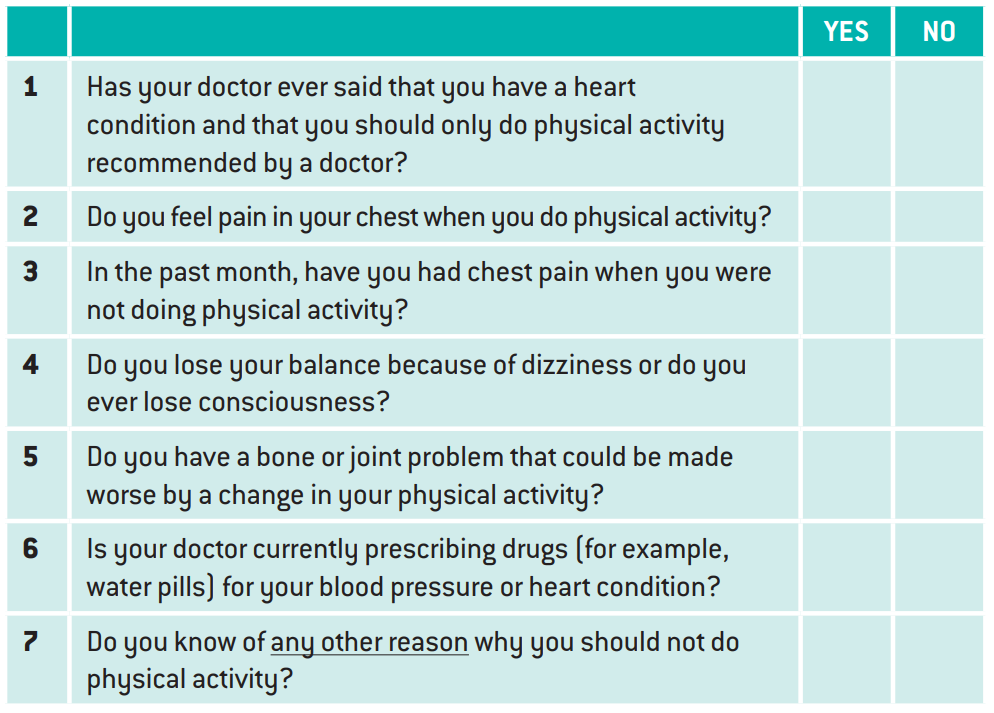
Evaluating Field, Laboratory, Sub-Maximal, and Maximal Tests
Field Tests
Conducted in a real-world setting, often replicating the environment of a specific sport or activity (e.g., running a timed lap on a track).
Advantages: Specific to the sport, readily available equipment, reflects real-world demands.
Disadvantages: Environmental factors can influence results (weather, surface), and less precise measurement compared to lab tests.
Laboratory Tests
Performed in a controlled environment with specialized equipment (e.g., treadmill test with VO2 max measurement).
Advantages: Highly accurate and reliable data, controlled environment minimizes external factors, allows for precise physiological measurements.
Disadvantages: Expensive equipment, less sport-specific, might not translate perfectly to real-world performance.
Sub-maximal Tests
Push participants to a challenging but sustainable level, stopping well before exhaustion. (e.g., heart rate monitoring during a moderate jog).
Advantages: Less stress on the body, quicker recovery time, safer for individuals with health concerns.
Disadvantages: Requires estimating maximal capacity from sub-maximal performance, a less precise measure of peak ability.
Maximal Tests
Demand participants exert themselves to the point of exhaustion (e.g., Wingate anaerobic test).
Advantages: Direct measure of peak performance capabilities.
Disadvantages: Requires high motivation and effort, can be physically demanding, and potentially risky for some individuals.
6.3 Compoenents of Fitness
Health-Related Fitness vs Performance-Related Fitness
Health-related
Health-Related Factors: physiologically base and determine the ability of an individual to meet the physical demands of the activity.
body composition (endomorph, ectomorph, mesomorph - the percentage of the body that is fat, muscle, or bone
cardio-respiratory fitness (aerobic capacity)
flexibility (range of movement possible at a joint)
muscular endurance (the ability for the muscles to be used for long periods)
strength (the ability of the muscles to exert large amounts of force)
Each of the components is required to a certain extent for day-to-day activity. A person would need cardiovascular endurance to make the walk up the stairs to get to work for example. The focus of health-related fitness is to improve the overall health of an individual.
Health-related fitness benefits all activities, including sports.
Performance-related fitness is specific to each sport (e.g., sprinter needs speed, tennis player needs agility).
Some performance-related components (balance, coordination) become health-related for certain populations (e.g., elderly).
Skill related
Skill-Related Factors: based upon the neuromuscular system and determine how successfully a person can perform a specific skill.
Agility
Balance
Coordination
Power
Reaction time
Speed
Specialized components are needed more during sports events.
Fitness Tests
Health Related
Aerobic Capacity
the ability to provide and sustain energy aerobically.
→ dependent on the ability of the cardiovascular system to transport and utilize oxygen during sustained exercise.

Flexibility
the range of movement at a joint.
→ determined by the elasticity of ligaments and tendons, the strength and opposition of surrounding muscles, and the shape of articulating bones.
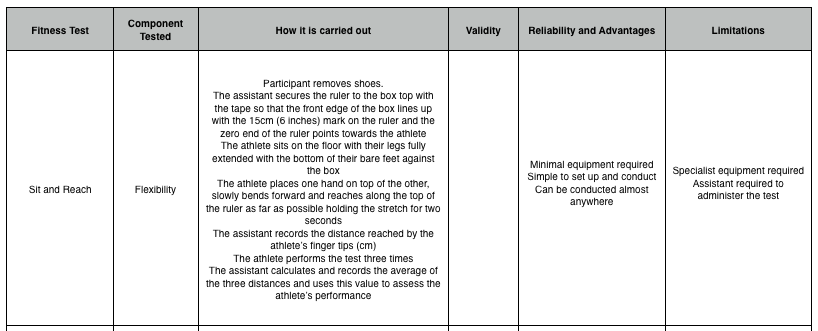
Muscular Endurance
the ability of a particular muscle group to keep working at the derided level of effort for as long as the situation demands. It is often controlled by the body’s tolerance to the increasing levels of lactic acid which the activity crates.
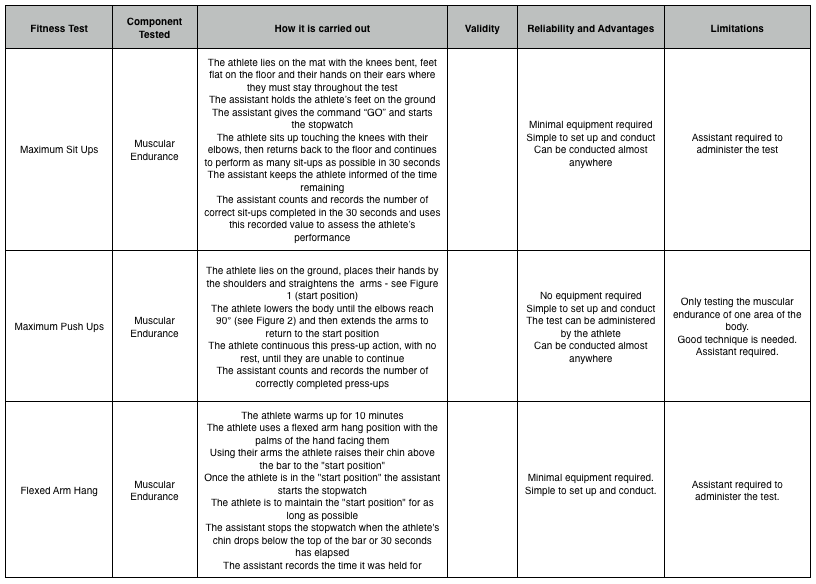
Strength
the maximum force that can be developed in a muscle or group of muscles in a single maximal contraction.

Skill-Related
Agility
the ability to move and change direction and position of the body quickly and effectively while under control.
→ includes coordination, balance, speed, and flexibility.

Speed
the ability to put the body parts into motion quickly, or the maximum rate that a person can move over a specific distance.

Balance
the maintenance of the center of mass over a base of support while the body is static or dynamic.

Coordination
the interaction between motor and nervous systems; the ability to perform motor tasks accurately and effectively.

Power
a powerful movement achieved as quickly as possible; the combination of strength and speed.

Reaction Time
the time taken to initiate a response to a given stimulus.
→ dependent on the ability of an individual to process information and initiate a response by the neuro-muscular system.

Body Composition
quantifying the different components of a human body. The selection of compartments varies by model but may include fat, bone, water, and muscle.

Multistage Fitness Test (Cardio-Respiratory Fitness)
Description: This involves running back and forth between cones set at increasing distances with progressively shorter rest periods. Each stage has a designated speed, and participants have to maintain that pace to continue. The test ends when a participant fails to complete a stage or stops due to exhaustion.
Validity and Reliability: The test is considered valid for estimating VO2 max (maximal oxygen uptake) in healthy individuals, but less so for those with pre-existing conditions. Reliability can be good with proper administration and participant motivation.
Limitations: Requires specific equipment (cones, audio guide), and supervision, and may not be suitable for beginners or those with limited mobility. Is not suitable for long-distance runners. The test if done properly is a test of maximal anaerobic capacity, and can therefore be dangerous to participants despite offering accurate results.
Cooper Run
Description: A simple test where participants run or walk as far as they can in 12 minutes. Distance covered is used to estimate VO2max.
Validity and Reliability: Reasonably valid for estimating VO2max in adults, especially compared to other field tests. Reliability can be affected by factors like pacing strategy and motivation.
Limitations: Requires a track or measured course. Performance can be influenced by weather conditions and running experience.
Harvard Step Test
Description: Participants step on and off a platform at a predetermined rate (usually 30 steps per minute) for five minutes or until exhaustion. Heart rate is then measured during recovery periods. A scoring system based on recovery time and heart rate is used to estimate aerobic fitness.
Validity and Reliability: Moderately valid for estimating VO2 max, particularly in individuals who cannot perform running tests. Reliability can be good with proper administration.
Limitations: Requires a specific platform height and controlled environment. May not be suitable for people with knee or ankle issues.
6.4 Principles of Training
General Training Program
1. Warm-up and stretching should be included in a general training program and should be the first thing done before the main event is carried out. This is because the warm-up prepares the body for the more strenuous exercise that is about ready to occur. To do this the warm-up increases heart rate and breathing rate and warms the body up.
Static Stretching: stretching exercises that are performed without movement.
Active Stretching: slow stretching in which flexibility is achieved without assistance. The contraction of the opposing muscles helps to relax the stretched muscles.
Passive Stretching: a slow stretching in which flexibility is achieved with a partner or apparatus to further stretch the muscles and joints.
2. A general training program should also include a cool down to slowly reduce the intensity of the activity done as the main event. This slow decline from an endurance activity helps prevent muscle soreness due to a build-up of the bye product of lactic acid. To maintain flexibility and help keep muscles loose the cool down should also include stretching activities.
3. A general training program should also include recreational activities to keep the performer enjoying sport and keeping relaxed and healthy. Doing these sorts of activities contributes to both better physical and mental well-being.
Proprioceptive Neuromuscular Facilitation (PNF): A progression on passive stretching, whereby after the stretch is held, the muscles are contracted isometrically. Also known as the CRAC (contract relex antagonist contraction) method.
Key Principles of Training Program Design
Progression: gradually increasing the amount of exercise.
Overload (frequency, intensity, and duration): FITT principles.
Specificity: The process of replicating the characteristics of physical activity in training to ensure its beneficial performance.
Reversibility: How long it takes to lose that base fitness. If the athlete does not use it, she/he will lose it.
Variety: Providing different activities, formats, and drills in training while still addressing the aims of the training program. Also helps decrease boredom.
Periodization: A structured, organized approach to training.
Monitoring Exercise Intensity
Karwonen Method
The Karvonen or percent heart rate reserve method (HRR) considers the difference between resting heart rate (HRrest) and maximal heart rate (HRmax). The training heart rate is calculated by taking a percentage of HRR and adding it to the HRrest. It is important to select an exercise intensity appropriate to the health needs and fitness status of the individual.
A training heart rate can be established by using the concept of maximum heart rate resource
Max Heart Rate = 200 - age
Heart Rate Reserve = MHR - HR rest
Karoven suggests that an aerobic training zone of 60-75% of the max HHR reserve should be used when designing training programs. This confirms that work is done at the correct intensity. This allows a training rate to be calculated
THR 75% = HR rest + 0.75 (HR max - HR rest)
Perceived Exertion
Exercise intensity: level of stress during exercise.
Indirectly related to exercise duration.
Measured in various ways:
Percentage of maximal aerobic capacity (VO2max)
Peak oxygen consumption
Percent VO2 reserve: the difference between V·O2max and resting oxygen consumption
Requires specialized equipment (e.g., metabolic carts) for accurate measurement.
